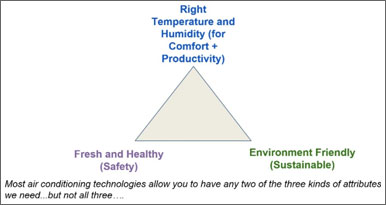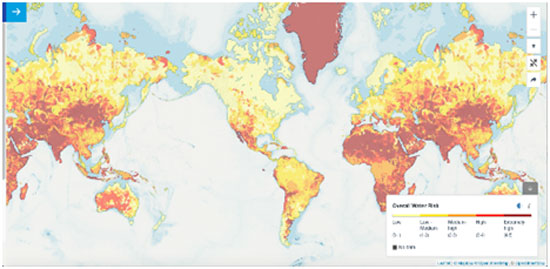
Technology Exists, Industry Needs A Mindset Shift To Achieve Sustainability With Safety
Most times in the years before 2020 when we thought about safety we would think of the kinds of things that could be called either careful behaviour or accident prevention - don't go rock climbing, or motorcycle or car racing, without proper training and gear; wear safety glasses, shoes, gloves, helmets, …we would think of interlocks on machines, our attitude, and take action in case of incidents. In 2020 though, safety most often refers to Covid-19. We’re thinking more about air.
Sustainable development can be defined as development that meets the needs of the present without compromising the ability of future generations to meet their own needs. The UN’s Brundtland Commission in 1987 identified three pillars of sustainable development as economic growth, environmental protection, and social equality.
This is widely recognised as the correct approach today - and that is why the United Nations and most of the countries have adopted sustainable development goals that include indicators that relate to people, planet, and economic growth. Environmental sustainability involves many factors. Of prime importance is carbon dioxide and climate change. There are other factors as well - air quality, water, and land. Let’s see how these are also related to carbon emissions.
Indirect evaporative cooling for fresh, sustainable air
Many of us often experience the problems of air quality. Research shows that air pollution is contributing to millions of deaths each year. It's a bigger factor than many diseases that we tend to take more seriously. It is estimated to account for 1 in 9 deaths globally and is the fourth leading risk factor for death on the planet. Indoors, good, fresh air is essential for health and productivity, which directly translate into economic terms. Good air for people is a great investment! Fresh air is actually the first line of defense against airborne diseases like colds, flu, Covid and other infections.
[caption id="attachment_20352" align="alignleft" width="386"] Economic-safety-sustainability challenge of air[/caption]
But here we run into a safety-sustainability paradox that we need to resolve. Three aspects of air are important -
Economic-safety-sustainability challenge of air[/caption]
But here we run into a safety-sustainability paradox that we need to resolve. Three aspects of air are important -
- The right temperature and humidity for comfort and productivity
- Fresh and healthy air
- Environment-friendly or sustainable with low energy consumption
 Water risk atlas[/caption]
In this situation, how do we get water for our industry? And face the twin challenges of making freshwater available every day for production needs, but also ensuring zero pollution? The answer is to change our mindset and own the idea that the most secure source of water is actually wastewater. If we can do this, we solve both challenges in one go: convert waste to value by recycling precious clean water from wastewater; generate biogas from wastewater and also recover energy and nutrient potential from biosludge. Less cost of water transport means further reduced carbon emissions.
There are business gains because of this as well: regulatory compliance; sustainable growth; enhanced brand image and improved product acceptability in the market; and better price realisation. You also have the satisfaction that you are doing the right thing and that your business will be able to continue in the future because you are not depleting valuable water resources.
Recycling – a need and a long term business opportunity
What about converting textile waste to wealth? A wonderful flow chart from leading consultants, Gherzi, shows the flow of hundreds of millions of tons of textile material in the added value chain and of the textile waste chain.
With such a high volume of textile material made every year, you can imagine that all this material at the end of its life takes up a lot of space, taking away land that could be used by nature. This is the kind of waste that needs to be recycled to free up land on the one hand and if you're smart about doing it then we can also save a lot of energy and water.
As Gherzi has pointed out, this idea needs to be taken to its logical conclusion and we need to work very hard on recycling much more. This chart from Gherzi shows some of the potential in percentages. It’s a huge potential business opportunity.
There are also some European regulations which mandate that producers take responsibility once again, at the end of product life. Perhaps we need a mindset shift to view our most secure source of our textile raw material as waste textile material. I think that the base technologies are there - though there is a question of getting some intermediate pieces of technology, and driving these to scale.
Digitalisation can drive sustainability
Another important step that we can take to manage sustainably is that of digitalisation. The vision is that you can get wisdom from data - and transform from a hindsight driven, to a foresight driven organisation in the process.
The new technologies of the internet of things (IoT) and the speed with which these can manage and process data allow us to move first from descriptive analytics - a description of what happened; to diagnostic analysis - and answer the question of why it happened; then you can move to predictive analytics and think of what will happen; and finally, to prescriptive analytics and answer the question of what is the best thing to do.
With IoT there are many advantages for sustainability. For example, we can decrease the specific energy and water consumption; reduce carbon emissions; enhance indoor air quality and actually build sustainable savings. In some of the projects that we've done, we've seen savings of 1-5% on overall cost savings of water and energy of around 15% and so 15% of carbon emissions as well. The payback on such investments is just a few months.
There are problems though with the widespread adoption of the Internet of Things in the textile industry where we find that the heterogeneity of deployment - the lack of a digital interface in older machines, as well as many different interface standards and protocols, proprietary protocols, etc., create a real problem that leads to a high cost of digital enablement. It is important for the textile industry, textile machinery manufacturers, and global bodies like the ITMF to collaborate to formulate best practices and standards to help digital adoption in the textile industry worldwide.
To summarise, safety and sustainability are extremely important subjects and they are deeply interconnected. There are solutions available to solve the problems of air, water, waste and climate change, in fact, there’s a business opportunity therein. And digitalization can be a very important platform to put all of these ideas together.
(This article is a slightly edited version of the comments made by Anuj Bhagwati, Head A.T.E. Group, in a recent industry panel discussion entitled ‘Safety and Sustainability in the Textile Industry’.)
Water risk atlas[/caption]
In this situation, how do we get water for our industry? And face the twin challenges of making freshwater available every day for production needs, but also ensuring zero pollution? The answer is to change our mindset and own the idea that the most secure source of water is actually wastewater. If we can do this, we solve both challenges in one go: convert waste to value by recycling precious clean water from wastewater; generate biogas from wastewater and also recover energy and nutrient potential from biosludge. Less cost of water transport means further reduced carbon emissions.
There are business gains because of this as well: regulatory compliance; sustainable growth; enhanced brand image and improved product acceptability in the market; and better price realisation. You also have the satisfaction that you are doing the right thing and that your business will be able to continue in the future because you are not depleting valuable water resources.
Recycling – a need and a long term business opportunity
What about converting textile waste to wealth? A wonderful flow chart from leading consultants, Gherzi, shows the flow of hundreds of millions of tons of textile material in the added value chain and of the textile waste chain.
With such a high volume of textile material made every year, you can imagine that all this material at the end of its life takes up a lot of space, taking away land that could be used by nature. This is the kind of waste that needs to be recycled to free up land on the one hand and if you're smart about doing it then we can also save a lot of energy and water.
As Gherzi has pointed out, this idea needs to be taken to its logical conclusion and we need to work very hard on recycling much more. This chart from Gherzi shows some of the potential in percentages. It’s a huge potential business opportunity.
There are also some European regulations which mandate that producers take responsibility once again, at the end of product life. Perhaps we need a mindset shift to view our most secure source of our textile raw material as waste textile material. I think that the base technologies are there - though there is a question of getting some intermediate pieces of technology, and driving these to scale.
Digitalisation can drive sustainability
Another important step that we can take to manage sustainably is that of digitalisation. The vision is that you can get wisdom from data - and transform from a hindsight driven, to a foresight driven organisation in the process.
The new technologies of the internet of things (IoT) and the speed with which these can manage and process data allow us to move first from descriptive analytics - a description of what happened; to diagnostic analysis - and answer the question of why it happened; then you can move to predictive analytics and think of what will happen; and finally, to prescriptive analytics and answer the question of what is the best thing to do.
With IoT there are many advantages for sustainability. For example, we can decrease the specific energy and water consumption; reduce carbon emissions; enhance indoor air quality and actually build sustainable savings. In some of the projects that we've done, we've seen savings of 1-5% on overall cost savings of water and energy of around 15% and so 15% of carbon emissions as well. The payback on such investments is just a few months.
There are problems though with the widespread adoption of the Internet of Things in the textile industry where we find that the heterogeneity of deployment - the lack of a digital interface in older machines, as well as many different interface standards and protocols, proprietary protocols, etc., create a real problem that leads to a high cost of digital enablement. It is important for the textile industry, textile machinery manufacturers, and global bodies like the ITMF to collaborate to formulate best practices and standards to help digital adoption in the textile industry worldwide.
To summarise, safety and sustainability are extremely important subjects and they are deeply interconnected. There are solutions available to solve the problems of air, water, waste and climate change, in fact, there’s a business opportunity therein. And digitalization can be a very important platform to put all of these ideas together.
(This article is a slightly edited version of the comments made by Anuj Bhagwati, Head A.T.E. Group, in a recent industry panel discussion entitled ‘Safety and Sustainability in the Textile Industry’.)

Textile Excellence
If you wish to Subscribe to Textile Excellence Print Edition, kindly fill in the below form and we shall get back to you with details.








